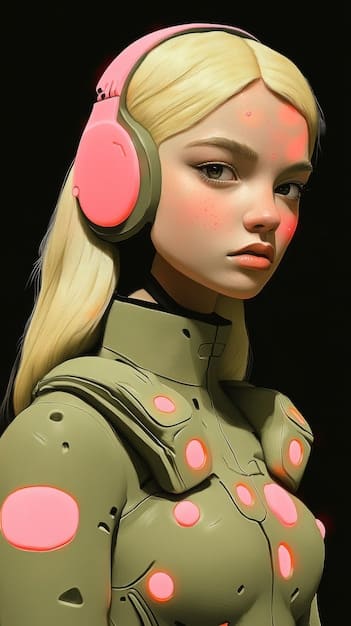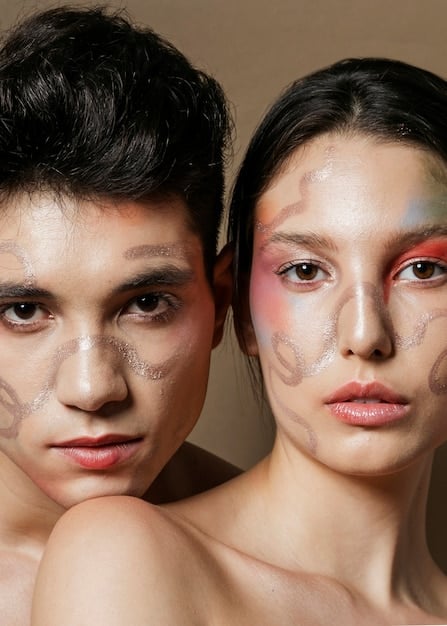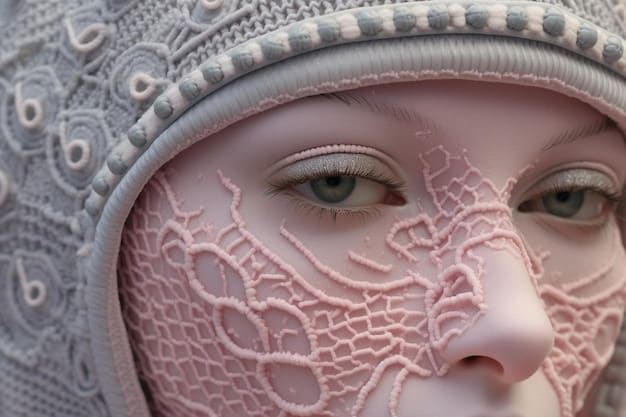Chroma Craze: Ultimate Guide to Skin Customization for Visual Impact

Chroma Craze is the art of customizing skins in games and digital platforms to achieve maximum visual impact, allowing players to express their unique style and stand out through personalized aesthetics.
Dive into the world of Chroma Craze: Mastering the Art of Skin Customization for Maximum Visual Impact, where we unlock the secrets to transforming your in-game characters and digital personas into uniquely expressive avatars. Discover how to leverage customization options for a truly standout visual presence.
Understanding the Basics of Skin Customization
Skin customization has become a cornerstone of modern gaming and virtual interaction. It’s no longer just about aesthetics; it’s about identity. Let’s explore the fundamentals of skin customization, setting the stage for mastering this art form.
What are Skins and Why Do They Matter?
Skins are digital assets that alter the appearance of characters, weapons, vehicles, or other items in a game or digital environment. They range from simple recolors to complex designs that completely transform the look of an item.
Skins matter because they offer a way for players to express individuality and creativity. A well-chosen or uniquely designed skin can make a player feel more connected to their character and more invested in the game.
The Psychology Behind Customization
The desire to customize and personalize is deeply rooted in human psychology. It stems from a need for self-expression and the desire to stand out from the crowd. Customization allows individuals to exert control over their digital appearance, reflecting their personal tastes and preferences.
- Identity Expression: Skins allow players to project a specific image or persona within the game.
- Social Status: Rare or exclusive skins can signify a player’s experience, skill, or investment in the game, conferring a sense of status.
- Emotional Connection: Players often develop an emotional attachment to their customized avatars, enhancing their overall gaming experience.
In conclusion, understanding the basics of skin customization involves recognizing its significance in self-expression and the psychological factors that drive players to seek unique and personalized digital identities.
Exploring Different Types of Skin Customization
Skin customization is not a one-size-fits-all concept. Different games and platforms offer a variety of customization options, each with its own unique features and possibilities. Let’s delve into the various types of skin customization available.

Preset Skins vs. Customizable Options
Some games offer preset skins that players can purchase or unlock. These skins are pre-designed and offer limited customization options, such as color variations or minor adjustments.
On the other hand, some games feature robust character editors that allow players to create entirely unique skins from scratch. These editors often include options to adjust facial features, hairstyles, clothing, accessories, and more.
Layered Clothing and Accessories
Layered clothing systems allow players to equip different clothing items and accessories to create unique outfits. This type of customization offers a high degree of flexibility, as players can mix and match various items to achieve their desired look.
- Individual Pieces: Separating clothing into individual pieces (shirts, pants, hats, etc.) allows for endless combinations.
- Accessory Options: Accessories like glasses, jewelry, and backpacks can further enhance the look of a customized skin.
- Color and Texture: The ability to change the color and texture of clothing items adds another layer of customization.
In summary, exploring different types of skin customization reveals a spectrum of options, from simple preset skins to complex layered clothing systems, each offering a unique approach to personalization and visual expression.
Color Theory and Skin Design
Color plays a crucial role in skin design, influencing how a skin is perceived and its overall visual impact. Understanding color theory can significantly enhance the effectiveness of your skin customization efforts. Let’s explore the key principles of color theory and how they apply to skin design.
Understanding Color Harmonies
Color harmonies are combinations of colors that create visually pleasing and balanced effects. Common color harmonies include complementary, analogous, triadic, and monochromatic.
When designing skins, consider using color harmonies to create visually appealing and cohesive designs. For example, complementary colors (e.g., blue and orange) can create a vibrant and dynamic contrast, while analogous colors (e.g., blue, blue-green, and green) offer a harmonious and calming effect.
The Impact of Color Psychology
Colors evoke different emotions and associations, influencing how a skin is perceived. Understanding color psychology can help you create skins that convey specific messages or emotions.
- Red: Associated with passion, energy, and excitement.
- Blue: Represents calm, trust, and stability.
- Green: Symbolizes nature, growth, and harmony.
- Yellow: Conveys happiness, optimism, and energy.
By carefully selecting colors and considering their psychological impact, you can create skins that resonate with players and enhance their overall experience.
In conclusion, mastering color theory and understanding its application in skin design is essential for creating visually striking and emotionally resonant skins that capture attention and convey the desired message.
Advanced Techniques for Skin Customization
Once you have a grasp of the basics, you can explore advanced techniques to take your skin customization skills to the next level. These techniques involve more intricate design elements and a deeper understanding of visual aesthetics. Let’s dive into some advanced techniques for skin customization.

Shading and Highlighting
Shading and highlighting are essential techniques for adding depth and dimension to skins. By strategically applying light and shadows, you can create the illusion of volume and realism.
Use darker shades to create shadows in recessed areas and lighter shades to highlight protruding areas. Experiment with different blending modes and opacity levels to achieve the desired effect.
Texture and Pattern Overlays
Texture and pattern overlays can add visual interest and complexity to skins. Textures can simulate different materials, such as leather, metal, or fabric, while patterns can add decorative elements.
- Seamless Textures: Use seamless textures to create a continuous and realistic surface appearance.
- Pattern Variety: Experiment with different patterns, such as stripes, polka dots, or geometric designs, to add visual interest.
- Layering Effects: Combine multiple textures and patterns to create complex and unique designs.
In summary, mastering advanced techniques like shading, highlighting, and texture overlays can significantly enhance the visual quality and complexity of your skin customizations, setting your designs apart from the rest.
Tools and Software for Skin Creation
Creating high-quality skins often requires the use of specialized tools and software. These tools provide the features and capabilities needed to design, edit, and export skins for various games and platforms. Let’s explore some of the popular tools and software used for skin creation.
Popular Skin Editing Software
Several software options are available for creating and editing skins. These programs offer a range of features, from basic image editing to advanced 3D modeling and texturing capabilities.
Popular choices include Adobe Photoshop, GIMP, and Substance Painter. Each program has its own strengths and weaknesses, so choose the one that best suits your needs and skill level.
Game-Specific Skin Editors
Some games offer their own built-in skin editors, which are specifically designed to work with the game’s assets and engine. These editors often provide a streamlined workflow and access to unique features and capabilities.
- Easy Integration: Game-specific editors seamlessly integrate with the game, allowing you to easily import and test your skins.
- Unique Features: These editors often include features tailored to the game’s specific art style and requirements.
- Community Resources: Many games have active communities that share tutorials, tips, and resources for using the built-in skin editor.
In conclusion, choosing the right tools and software is crucial for efficient and effective skin creation. Whether you opt for general-purpose image editing software or game-specific editors, mastering these tools will empower you to bring your skin design ideas to life.
Monetizing Your Skin Customization Skills
If you’re skilled at creating skins, you may be able to monetize your talents and turn your hobby into a source of income. Several avenues exist for selling and sharing your skin designs. Let’s explore the various ways you can monetize your skin customization skills.
Selling Skins on Marketplaces
Many online marketplaces specialize in buying and selling virtual goods, including skins. These marketplaces provide a platform for you to showcase your designs and reach a wide audience of potential buyers.
Popular marketplaces include the Steam Community Market, DMarket, and OPSkins. Be sure to research each platform’s fees and policies before listing your skins for sale.
Creating and Selling Skin Mods
Skin mods are modifications that alter the appearance of games or software. Creating and selling skin mods can be a lucrative way to monetize your customization skills, especially for popular games with active modding communities.
- Modding Communities: Join modding communities to connect with fellow modders and potential customers.
- Tutorials and Documentation: Create tutorials and documentation to help users install and use your skin mods.
- Exclusive Content: Offer exclusive skins or features for premium subscribers or patrons.
In summary, monetizing your skin customization skills can be a rewarding endeavor. Whether you choose to sell skins on marketplaces or create and sell skin mods, there are numerous opportunities to turn your passion into profit.
The Future of Skin Customization
The world of skin customization is constantly evolving, driven by technological advancements and changing player preferences. Let’s take a look at some of the trends and developments that are shaping the future of skin customization.
AI-Powered Skin Generation
Artificial intelligence (AI) is increasingly being used to generate skins automatically based on user preferences or input. AI-powered skin generation tools can create unique and personalized skins in a fraction of the time it would take a human designer.
Augmented Reality Skins
Augmented reality (AR) technology is opening up new possibilities for skin customization, allowing players to overlay virtual skins onto their real-world appearance. AR skins can be used in social media apps, video calls, or even in-person interactions.
- Virtual Avatars: AR skins can transform your appearance in real-time, allowing you to embody virtual characters or personas.
- Interactive Experiences: AR skins can be integrated with games and apps to create interactive and immersive experiences.
- Personalized Expression: AR skins can be customized to reflect your personal style and preferences, allowing you to express yourself in new and creative ways.
In conclusion, the future of skin customization is bright, with AI and AR technologies pushing the boundaries of what’s possible. As these technologies continue to evolve, we can expect even more innovative and immersive skin customization experiences in the years to come.
| Key Point | Brief Description |
|---|---|
| 🎨 Basics of Skin Customization | Understanding the role and importance of skins in gaming and virtual environments. |
| 🌈 Color Theory | Using color harmonies and psychology to design appealing and effective skins. |
| 🛠️ Advanced Techniques | Applying shading, highlighting, and textures for detailed skin designs. |
| 💰 Monetizing Skills | Strategies for selling or creating skin mods to earn income. |
FAQ
▼
Skins are cosmetic items that change the visual appearance of characters, weapons, or vehicles in video games. They don’t usually affect gameplay but allow players to personalize their in-game experience.
▼
Skins can be obtained through various methods, including in-game purchases, rewards for completing challenges, or as drops from loot boxes. Some skins are also available through special events or promotions.
▼
Yes, many games offer tools or support for creating custom skins. You can use software like Photoshop or game-specific editors to design and import your own skins, provided the game allows it.
▼
Some rare or highly sought-after skins can be worth significant real money, especially in games where they can be traded or sold on marketplaces. This value depends on rarity, demand, and the game’s economy.
▼
Color harmony refers to the use of pleasing color combinations, like complementary or analogous colors, to create visually appealing skins. These combinations ensure balance and aesthetic appeal in the skin’s design.
Conclusion
Mastering the art of skin customization is a multifaceted journey, blending creativity, technical skills, and an understanding of player psychology. From grasping the fundamentals of color theory to exploring advanced techniques like shading and texturing, the path to creating compelling skins is both challenging and rewarding. As technology advances, the possibilities for skin customization will only continue to expand, offering even more opportunities for self-expression and innovation in the digital world.





